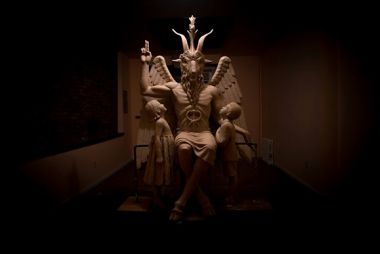Satan has come to Detroit: Try not to worry

Lucifer is visiting Detroit, and the locals aren't happy about it.
A giant bronze statue – it weighs a ton and stands nearly nine feet tall – depicting the figure of Baphomet, the Satanic figure supposedly worshipped by the Knights Templar, has been erected at an industrial building near the Detroit River. Its promoters, The Satanic Temple, orginally hoped that it would be installed near a stone 10 Commandments monument on the Oklahoma State Capitol grounds, but it was vetoed.
Baphomet's stay in Detroit is only temporary: they aim to transport the sculpture to Arkansas, where earlier this year the governor signed a bill authorising another 10 Commandments monument on the State Capitol's grounds.
The Detroit installation was met with predictable protests. "The last thing we need in Detroit is having a welcome home party for evil," said the Rev Dave Bullock, a pastor at Greater St Matthew Baptist Church in Highland Park, Michigan. "I'm here to stand against this being in the City of Detroit. We will not turn over our city to Satanists. It's a violent spirit that's moving to the city," said Bishop Corletta Vaughn of the Holy Ghost Cathedral in Detroit. Renla Session of Detroit came carrying a placard that said: "SATAN can not exist where there is truth and JESUS is the TRUTH."
The protests were predictable because, truth to tell, they were intended to be. The Satanic Temple is a good deal less Satanic and a good deal more sophisticated than its title might suggest – Satan is more of a philosophical trope than the Prince of Darkness. If its website is anything to go by, its members spend more time reading Anatole France than they do sacrificing virgins or tuning up their broomsticks. It's all about libertarianism, self-discovery and challenging American civil religion, which is far less exciting than protesters might wish. However, its use of traditionally Satanic symbols is guaranteed to tweak the tail-feathers of the American eagle, a thoroughly Christian bird, and so it has proved.
But it's worth asking what lies underneath the reaction to this statue, and what a better response might be. Because an image of a peculiar man-goat, whose iconography can't plausibly be traced further back than medieval times, has absolutely nothing to do with spiritual evil.
The development of the tradition has been catalogued in a magisterial five-volume series by historian Jeffrey Burton Russell (The Devil, Satan, Lucifer, Mephistopheles and The Prince of Darkness). Russell shows how each generation has reinvented the personification of evil for its own times.
What it speaks of is the human desire to give a shape to the shapeless – a desire so potent that it is a foundational principle of the great monotheistic religions that God cannot be visualised. In its teaching that God was incarnate in Christ, Christianity is at odds with both Judaism and Islam, but it is as firm as either of them in affirmation that God is known through words, not through images. An image sets limits to the imagination in a way that words don't. An image freezes a definition; it says, "This is how you are to think, and in no other way."
The images that have defined Satan over the years have been drawn from various sources, ranging from folk-myths through ecclesiastical black propaganda (like the 1487 Malleus Maleficarum, responsible for the deaths of countless so-called 'witches'), high art and literature (like Milton's Paradise Lost), to Hollywood (Ridley Scott's Legend, for instance). He even features in a Dr Who episode (The Satan Pit, 2006).
Designed to scare us, these images take on a life of their own, in a kind of spiritual feedback loop – and in doing so, they underline once again the wisdom of the Bible.
Images begin with drawing lines. Once you've drawn a line, you've included one thing and excluded everything else. If Satan is Baphomet (a man-goat? Seriously?) there's a whole bunch of other stuff he isn't: poverty, cruelty, racism, hunger, disease, selfishness, rage, spite: all the things that disfigure human beings in their relationships with each other and with God.
People who protest against images have a point. These things can become symbols of evil. But only if we make them so. Far, far better to smile indulgently at The Satanic Temple's posturing, admit it's probably right about the whole civil religion thing, and go and do some good – and never, ever forget that there's evil in the world, but that Christ is Lord.
Follow @RevMarkWoods on Twitter.











